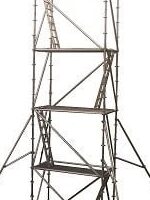scaffolding in construction is used in renovation, maintenance, and other activities it is a temporary, movable structure that is usually composed of steel or wooden components. Its purpose is to give workers a safe, elevated platform from which to access or work on structures such as buildings, bridges, or other high-reaching structures.
Functions of scaffolding in construction
Access: It gives employees a solid, safe way to access different areas of a building that would otherwise be hazardous or difficult to access. This is particularly important when painting, plastering, or putting fittings on high-rise buildings, for example.
Support: By supporting the weight of laborers, equipment, and building supplies, scaffolding lessens the strain on the supporting structure. This protects the workers’ safety and aids in preventing structural damage.
Safety: Guardrails, platforms, and other safety features are included in scaffolding designs to prevent falls and injuries. Additionally, it offers a controlled environment in which employees can carry out their duties.
Efficiency: It increases productivity and efficiency on construction sites by allowing workers to operate at different heights and places without having to relocate ladders or other equipment all the time.
There are many different types of scaffolding, such as suspended scaffolding, system scaffolding, frame scaffolding, tube and clamp scaffolding, and more. The particular needs of the project and the structure being worked on determine the sort of scaffolding that should be used. To guarantee stability and safety, scaffolding must be erected, inspected, and maintained by qualified experts. When working on or near scaffolding, it’s imperative to take the necessary safety precautions to avoid mishaps and injuries.
Types of Scaffolding in Construction:
Following are types of Scaffolding in construction:
- Single scaffolding
- Double scaffolding
- Cantilever scaffolding
- Suspended scaffolding
- Trestle scaffolding
- Steel scaffolding
- Patented scaffolding
1. Single Scaffolding in construction
Single scaffolding is generally used for brick masonry and is also called as brick layer’s scaffolding. Single scaffolding consists of standards, ledgers, putlogs etc., which is parallel to the wall at a distance of about 1.2 m. Distance between the standards is about 2 to 2.5 m. Ledgers connect the standards at vertical interval of 1.2 to 1.5 m. Putlogs are taken out from the hole left in the wall to one end of the ledgers. Putlogs are placed at an interval of 1.2 to 1.5 m.

2. Double Scaffolding
Double Scaffolding is generally used for stone masonry so, it is also called as mason’s scaffolding. In stone walls, it is hard to make holes in the wall to support putlogs. So, two rows of scaffolding is constructed to make it strong. The first row is 20 – 30 cm away from the wall and the other one is 1m away from the first row. Then putlogs are placed which are supported by the both frames. To make it more strong rakers and cross braces are provided. This is also called as independent scaffolding.

3. Cantilever Scaffolding
This a type of scaffolding in which the standards are supported on series of needles and these needles are taken out through holes in the wall. This is called single frame type scaffolding. In the other type needles are strutted inside the floors through the openings and this is called independent or double frame type scaffolding. Care should be taken while construction of cantilever scaffolding.
Generally cantilever scaffoldings are used under conditions such as
- When the ground does not having the capacity to support standards,
- When the Ground near the wall is to be free from traffic,
- When upper part of the wall is under construction.

4. Suspended Scaffolding
In suspended scaffolding, the working platform is suspended from roofs with the help of wire ropes or chains etc., it can be raised or lowered to our required level. This type of scaffolding is used for repair works, pointing, paintings etc..

5. Trestle Scaffolding
In Trestle scaffolding, the working platform is supported on movable tripods or ladders. This is generally used for work inside the room, such as paintings, repairs etc., up to a height of 5m.

6. Steel Scaffolding
Steel scaffolding is constructed by steel tubes which are fixed together by steel couplers or fittings. It is very easy to construct or dismantle. It has greater strength, greater durability and higher fire resistance. It is not economical but will give more safety for workers. So, it is used extensively nowadays.

7. Patented Scaffolding
Patented scaffoldings are made up of steel but these are equipped with special couplings and frames etc., these are readymade scaffoldings which are available in the market. In this type of scaffolding working platform is arranged on brackets which can be adjustable to our required level.

